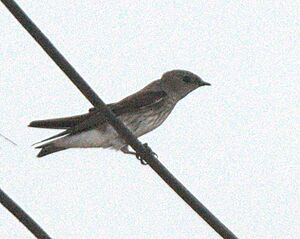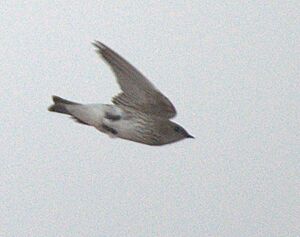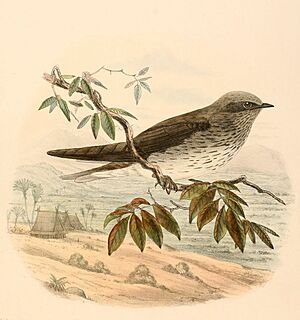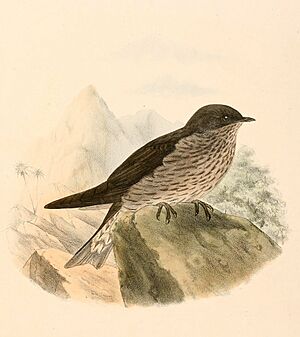Mascarene martin facts for kids
Quick facts for kids Mascarene martin |
|
|---|---|
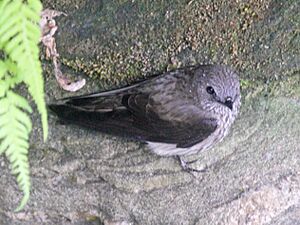 |
|
| At Ranomafana, Madagascar | |
| Conservation status | |
| Scientific classification | |
| Genus: |
Phedina
|
| Species: |
borbonica
|
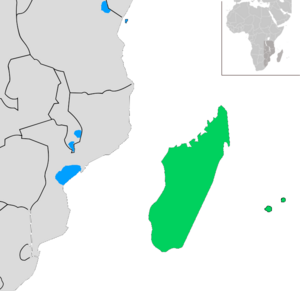 |
|
| Approximate range in Africa
Resident Non-breeding |
|
| Synonyms | |
|
Cotyle borbonica Gmelin, 1789 |
|
The Mascarene martin or Mascarene swallow (Phedina borbonica) is a small bird from the swallow family. It lives and raises its young in Madagascar and the Mascarene Islands. These islands are in the Indian Ocean.
There are two types, or subspecies, of Mascarene martin. One type lives on Mauritius and Réunion islands. It stays there all year. The other type is smaller and lives in Madagascar. This type is a migratory bird. It flies to East Africa for the winter. Sometimes, it also visits other islands in the Indian Ocean.
The Mascarene martin is a small bird. It has dark grey-brown feathers on its back. Its belly is grey-brown, turning white near its throat and lower tummy. Its belly also has many black stripes. It has a tail that is slightly forked. This bird builds its nest in small groups. They like sheltered spots like ledges, buildings, tunnels, or caves. The nest is a shallow cup made of twigs and plants. Usually, they lay two or three white eggs with brown spots.
Mascarene martins fly with slow, heavy wingbeats. They often glide through the air. You might see them resting on wires. They eat insects they catch while flying. They often hunt close to the ground or plants. In East Africa, they like to hunt in open areas. These areas are often where trees have been cut down.
Big storms called tropical cyclones can affect these birds. This is especially true on the smaller islands. But the Mascarene martin is a common bird in its home areas. Its numbers seem to be steady. Because of this, the International Union for Conservation of Nature (IUCN) says it is a species of Least Concern. This means it is not currently at risk of disappearing.
Contents
Discovering the Mascarene Martin
The Mascarene martin was first officially described in 1789. A German zoologist named Johann Friedrich Gmelin gave it the name Hirundo borbonica. He wrote about it in his book, which was based on the work of Carl Linnaeus. Gmelin learned about the bird from a French scientist. This scientist had described a "large brown swallow with a spotted belly" in 1779.
It is thought that another French naturalist, Philibert Commerson, might have described the bird earlier. But his notes and specimens were sadly destroyed. Later, in 1855, a French biologist named Charles Lucien Bonaparte moved the martin to a new group, or genus, called Phedina. The name Phedina comes from Greek and Italian words. They mean "brown swallow." The species name "borbonica" refers to Réunion Island. Its old French name was Île de Bourbon.
Types of Mascarene Martins
There are two main types of Mascarene martins. The first type is called P. b. borbonica. It lives on Mauritius and Réunion. The second type is P. b. madagascariensis. This type lives in Madagascar.
The Phedina group is part of the Hirundininae subfamily. This group includes all swallows and martins. Scientists study the DNA sequences of birds. This helps them understand how different bird groups are related. Swallows are grouped by how they build their nests. Some dig burrows, some use natural holes, and some build nests from mud. Mascarene martins dig burrows for their nests. This places them in the "core martins" group.
The Phedina group is believed to be an early branch from the main swallow family tree. The Brazza's martin was once in the same group as the Mascarene martin. But now it has its own group, Phedinopsis. This is because it has different calls and builds different nests.
What the Mascarene Martin Looks Like
Adult Mascarene martins from Mauritius and Réunion are about 15 cm (6 in) long. They weigh about 24 g (0.8 oz). Their upper parts are dark brown-grey. Their underparts are grey-brown, becoming white on the throat and lower belly. These parts have many black stripes. Their tail is slightly forked and has white edges. Their wings, beak, and legs are black. Their eyes are dark brown.
Young birds have less clear streaking on their chest. They also have white tips on their wing feathers. The Madagascan type of martin is paler overall. It has a larger beak. Its chest streaking is thicker, but its lower belly has only very fine lines. This type is smaller, about 12–14 cm (4.7–5.5 in) long. It weighs about 20.6 g (0.7 oz).
Sounds and Calls
The Mascarene martin is a fairly quiet bird. It has a warbling song that sounds like siri-liri siri-liri. It sings this song while flying or when resting on a perch. Some calls end with a sliding sound. They might use other sounds when mating or being aggressive. They have a "chip" sound for contact. Young birds make a fast chirping sound when they want food. Birds that spend winter in Africa are usually silent.
How to Tell Them Apart
No other streaked swallows live where the Mascarene martin breeds. In Africa, the lesser striped swallow is bigger. It has a deeply forked tail and very different colors. It has dark blue on its back, a red rump, and a chestnut-colored head. The brown-throated sand martin looks similar in shape and color. But it has plain, unstreaked underparts. The small Mascarene swiftlet has longer, narrower wings. It also flies much lighter. The Brazza's martin is smaller and has a plainer back. It has finer stripes on its throat and chest. But it does not live in the same areas.
Where Mascarene Martins Live
The Mascarene martin only breeds in Madagascar and the Mascarene Islands. The type from Mauritius and Réunion stays there. The Madagascan type is a migratory bird. It leaves the central plateau of Madagascar from April to September. It moves to lower areas or to mainland Africa.
It is not common in coastal Mozambique, Zambia, Malawi, and Pemba Island. It is very rare in Kenya and mainland Tanzania. But sometimes large groups spend the winter in Mozambique or Malawi. It has also been seen in the Comoros and other Indian Ocean islands. This includes at least four islands in the Seychelles. Some of these sightings might be birds blown off course by cyclones.
Favorite Places to Live
Mascarene martins can live anywhere that has good places to build a nest. This includes ledges, buildings, tunnels, caves, or rocky areas. On Réunion, they are found on the east side. On Mauritius, they live on the south and west coasts. They also live on inland cliffs on Mauritius.
Mascarene Martin Behavior
The Mascarene martin flies with slow wingbeats. It often glides. It likes to return to the same favorite resting spot. You can often see this martin perched on wires. Sometimes, it rests on sandy beaches. These birds sleep in small groups. They roost in bushes, on buildings, or on cliffs. Sometimes other birds, like blue-cheeked bee-eaters, join them.
Reproduction and Life Cycle
Mascarene martins build nests and lay eggs during the wet season. This is from August to November in Madagascar. On Mauritius and Réunion, it is from September to early January. They breed in small groups, usually a few pairs. But one group of about 20 pairs was seen on Mauritius.
The nest is a shallow cup. It is made of twigs and rough plant material like grass. It has a soft lining of feathers and finer plants. They build nests in flat places that predators cannot easily reach. This can be 3–5 m (10–16 ft) over water. One unusual nest was on a small boat.
They usually lay two eggs in Madagascar and Mauritius. On Réunion, they lay two or three eggs. The eggs are white with brown spots. They are about 21.6 mm (0.85 in) long and 15 mm (0.59 in) wide. They weigh about 2.5 g (0.09 oz). The female bird sits on the eggs to keep them warm. We do not know how long it takes for the eggs to hatch. We also do not know how long it takes for the young birds to leave the nest. The male bird helps feed the young. Parents continue to feed the chicks after they leave the nest.
How They Find Food
Mascarene martins catch insects while flying. They often fly low over the ground or plants. They hunt alone, in small groups, or with other swallows and swifts. They are most active just before it gets dark. Their diet includes beetles, bugs, and flying ants.
In Madagascar, they hunt in forests, farmlands, wetlands, and open areas. They can hunt at high altitudes, up to 2,200 m (7,200 ft). On Mauritius and Réunion, they hunt from sea level up to 1,500 m (4,900 ft). They hunt over lakes, coasts, cliffs, and near trees. In eastern Africa, they use areas where trees have been cut down for farming.
Predators and Parasites
Mascarene martins will chase and bother the Mauritius kestrel. This suggests they see it as a possible danger. Martins on Mauritius can get infected by a tiny parasite called Trypanosoma phedinae. We do not know if this parasite makes them sick. Other tiny blood parasites have also been found in martins on Mauritius.
A new type of louse fly was first found on a martin in Madagascar. Another bird from that island had a feather mite. This mite is usually found on parrots.
Conservation Status
The Mascarene martin breeds on only three islands. Madagascar is very large, but Réunion is much smaller. Even though its home range is limited, this bird is common on Mauritius and Réunion. It is also common in some areas of Madagascar. We do not know the exact number of these birds. But there are more than 10,000 adult birds. Their population seems to be stable. So, the International Union for Conservation of Nature (IUCN) lists it as a species of Least Concern. This means it is not in danger of extinction.
Tropical cyclones are a natural threat to these birds. This is especially true on the small islands. A strong cyclone in February 1861 badly affected the birds on Mauritius and Réunion. It took many years for the population to recover. But by 1900, they were common again. More recent cyclones, like one in 1980, did not cause as much damage.
Some species in this region are in danger. This is because they live on only one island. Or they are harmed by changes to their habitat or by introduced animals. Several species have disappeared from the Mascarene islands since humans arrived. But the Mascarene martin and the Mascarene Swiftlet live on all the main islands. They are less affected by human activities. This is also because they can use houses as places to build nests.
In Mauritius, the Mascarene martin is legally protected. It is against the law to kill these birds. It is also illegal to take or destroy their nests. This is under the Wildlife and National Parks Act of 1993. Madagascar and African countries have general laws to protect birds. But they do not have special rules just for this martin. Réunion is part of France. But European bird protection laws do not apply outside Europe.



